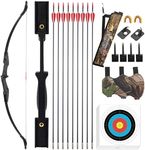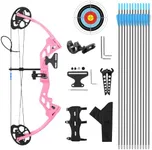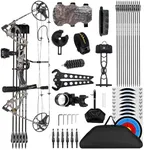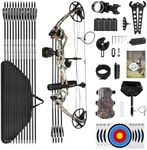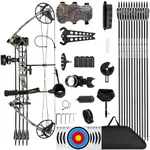Buying Guide for the Best Youth Bow And Arrow
Choosing the right youth bow and arrow is crucial for ensuring a safe, enjoyable, and successful archery experience for young archers. The right equipment can help build confidence, improve skills, and foster a love for the sport. When selecting a youth bow and arrow, it's important to consider several key specifications to ensure the equipment matches the archer's size, strength, and skill level. Here are the key specs to consider and how to navigate them.Draw WeightDraw weight refers to the amount of force required to pull back the bowstring. This spec is important because it affects how easily the archer can draw the bow and how much power the arrow will have. For youth archers, it's essential to choose a draw weight that they can handle comfortably. Typically, draw weights for youth bows range from 10 to 25 pounds. Beginners and younger children should start with a lower draw weight (10-15 pounds) to ensure they can draw the bow without strain. As they grow stronger and more experienced, they can move up to higher draw weights.
Draw LengthDraw length is the distance the bowstring is pulled back before release. This spec is crucial because it needs to match the archer's arm length for proper form and accuracy. To determine the correct draw length, measure the archer's arm span (from fingertip to fingertip) and divide by 2.5. Youth bows often have adjustable draw lengths to accommodate growth. Ensure the bow you choose has a draw length range that fits the archer's current measurement and allows for some growth.
Bow Size and WeightThe size and weight of the bow are important for comfort and ease of use. A bow that is too large or heavy can be difficult for a young archer to handle, leading to poor form and potential injury. Youth bows are designed to be lighter and more compact than adult bows. When choosing a bow, consider the archer's age, size, and strength. A smaller, lighter bow is generally better for younger or smaller children, while older or larger youth may be able to handle a slightly bigger and heavier bow.
Bow TypeThere are different types of bows, including recurve bows, compound bows, and longbows. Each type has its own characteristics and benefits. Recurve bows are simple and traditional, making them a good choice for beginners. Compound bows have a more complex design with pulleys and cables, offering greater power and accuracy, which can be beneficial for more advanced youth archers. Longbows are less common but offer a unique shooting experience. Consider the archer's experience level and interest in the sport when choosing the bow type.
Arrow SelectionChoosing the right arrows is just as important as selecting the right bow. Arrows come in different lengths, materials, and weights. The length of the arrow should match the draw length of the bow. Arrows that are too short can be dangerous, while arrows that are too long can affect accuracy. Common materials for youth arrows include fiberglass, aluminum, and carbon. Fiberglass arrows are durable and affordable, making them a good choice for beginners. Aluminum and carbon arrows are lighter and more accurate but can be more expensive. Consider the archer's skill level and the type of bow when selecting arrows.

